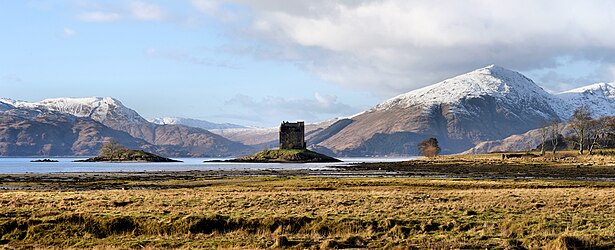Castle Stalker
| Castle Stalker | |
|---|---|
 Castle Stalker with the Lynn of Lorne and Lismore beyond | |
 | |
| General information | |
| Location | Argyll and Bute |
| Town or city | Tidal island on Loch Laich |
| Country | Scotland |
| Website | |
| castlestalker | |
Castle Stalker (Scottish Gaelic: Caisteal an Stalcaire) is a four-storey tower house or keep in the Scottish county of Argyll. It is set on a tidal islet on Loch Laich, an inlet off Loch Linnhe. It is about 1+1⁄2 miles (2.5 kilometres) north-east of Port Appin and is visible from the A828 road about midway between Oban and Glen Coe. The islet is accessible with difficulty from the shore at low tide. The name "Stalker" comes from the Gaelic Stalcaire, meaning "hunter" or "falconer". The island castle is one of the best preserved medieval tower houses to survive in western Scotland and is a Category A listed building.[1][2] It stands in the Lynn of Lorn National Scenic Area.[3]
History
The original castle was a small fort built around 1320 by Clan MacDougall, who were then Lords of Lorn.[4] Around 1388 the Stewarts took over the Lordship of Lorn, and it is believed that they built the castle in its present form around the 1440s. The Stewarts' relative King James IV of Scotland visited the castle, and a drunken bet around 1620 resulted in the castle passing to Clan Campbell.[4] After the castle changed hands between these clans a couple of times, the Campbells finally abandoned it about 1840 when it lost its roof. In 1908 the castle was bought by Charles Stewart of Achara, who carried out basic conservation work. In 1965 Lt. Col. D. R. Stewart Allward acquired the castle and over about ten years fully restored it. Castle Stalker remains in private ownership and is open to the public at selected times during the summer.[5]
For the 2011 census the island on which the castle stands was classified by the National Records of Scotland as an inhabited island that "had no usual residents at the time of either the 2001 or 2011 censuses."[6]
In popular culture
Castle Stalker has been used as a location for the filming of multiple works including:
- Monty Python and the Holy Grail (as "The Castle Aaaaarrrrrrggghhh")
- Highlander: Endgame[7]
- Sense8 (as the estate of the "Old Man of Hoy")[8]
- Black Mirror, "Loch Henry"
Castle Stalker is the inspiration for Castle Keep in the children's book The Boggart.[9]
References
- ^ "Visit Fort William".
- ^ Historic Environment Scotland. "Castle Stalker (Category A Listed Building) (LB12345)". Retrieved 28 March 2019.
- ^ "National Scenic Areas" Archived 2017-03-11 at the Wayback Machine. SNH. Retrieved 30 March 2011.
- ^ a b Allward, Ross. S.S. (March 2011). "A Brief History". Castle Stalker. Retrieved 23 June 2023.
- ^ "Visitor Info". Castle Stalker. Retrieved 5 August 2022.
- ^ National Records of Scotland (15 August 2013). "Appendix 2: Population and households on Scotland's Inhabited Islands" (PDF). Statistical Bulletin: 2011 Census: First Results on Population and Household Estimates for Scotland Release 1C (Part Two) (PDF) (Report). SG/2013/126. Retrieved 14 August 2020.
- ^ "Highlander: Endgame - Castle Stalker". Scotland the Movie. Retrieved 19 October 2013.
- ^ "Sense8, A Netflix Original". Argyll and Bute Council. 5 May 2017. Retrieved 11 December 2022.
- ^ "Susan Cooper on Writing the Boggart".

